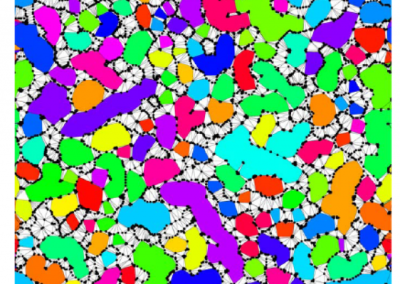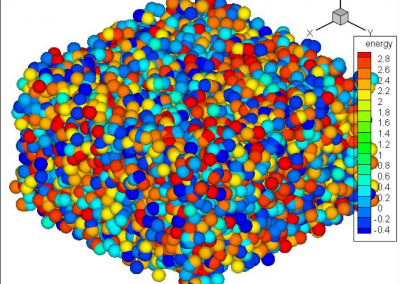Increasing Solar Cell Efficiency
Overview
Our “Project Full Spectrum Boost” focuses on solar cells made of colloidal nanoparticles (NPs). The NPs are designed to boost absorption at low energies by supporting the Intermediate Band (IB) process. The IB implementations include core-shell NPs, surface/bulk-doped NPs, structurally relaxed NPs, and NP mixtures. The same NPs are designed to boost absorption at high energies by Carrier Multiplication (CM): high energy electrons relaxing by generating multiple excitons. CM is driven by the NP quantum confinement enhancing the Coulomb interaction. However, quantum confinement also disadvantageously enhances the gap and makes charge extraction harder. This is QCD: the Quantum Confinement Dilemma. We are “transcending QCD” by reducing the gap and at the same time enhancing CM by NP structural relaxation and using exotic, high pressure phase NP cores. Transport in the solar cell devices is modeled by Monte Carlo hopping or Boltzmann band-transport theories.
How
We are part of the NSF supported Solar Collaborative project with co-PIs G. Galli, S. Carter, S. Kauzlarich, and D. Larsen to synthesize, characterize and fabricate nanoparticle solar cells, as well as to simulate them by advanced theoretical methods. We use ab initio methods to determine the electronic properties of nanoparticles. These include:
- Quantum Espresso LDA for one particle band structure, GW for improved energy levels
- Time dependent DFT for absorption
- Many body perturbation theory for Impact Ionization rates
- Bethe-Salpeter equations and Lanczos methods for the dielectric matrix
- QBox Molecular Dynamics for structural relaxation
- Ab initio-based Kinetic Monte Carlo with Miller-Abrahams and Markus dynamics for transport modeling
Talks
- 2018 A Deliberate Journey, Harvard – Part I and Part II
- 2017 The Full Spectrum Boost Project: Upconversion, Downconversion and Transport in Nanoparticles Solar Cells, Telluride, CO
- 2016 The Full Spectrum Boost Project: Upconversion, Downconversion, Transport Los Alamos
- 2014 Full spectrum Boost in Nanoparticle Solar Cells Stanford
- 2014 Hierarchical Transport Modeling in Nanoparticle Solar Cells APS-invited
Papers
- 2022. A. Abelson, C. Qian, Z. Crawford, G. T. Zimanyi, M. Law. High-Mobility Hole Transport in Single-Grain PbSe Quantum Dot Superlattice Transistors Nano Lett. 2022, 22, 23, 9578–9585
- 2022. M. Kovtun, Z. Crawford, A. Goga, G. T. Zimanyi, Critical transport behavior in quantum dot solids 2022 IEEE 49th Photovoltaics Specialists Conference (PVSC), Philadelphia, PA, USA, 2022, pp. 1062-1064, doi: 10.1109/PVSC48317.2022.9938887
- 2021. X. Chu, H Heidari, A Abelson, D. Unruh, C. Hansen, C. Qian, G. T. Zimanyi, M. Law, A. J. Moule Structural characterization of a polycrystalline epitaxially-fused colloidal quantum dot superlattice by electron tomography Nanoengineering: Fabrication, Properties, Optics, Thin Films, and Devices XVIII. Vol. 11802. SPIE, 2021.
- 2021. L. Qu, D. Unruh, and G. T. Zimanyi Percolative Charge Transport In Binary Nanocrystal Solids Phys. Rev. B, 103, 195303.
- 2021. C. Hansen, D. Unruh, M. Alba, C. Qian, A. Abelson, M. Law, G. T. Zimanyi. Hierarchical Carrier Transport Simulator for Defected Nanoparticle Solids: TRIDENS Scientific Reports (Nature group), 11, 1-12.


